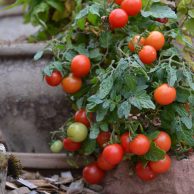
Vilma Tomato courtesy Sara’s Kitchen Garden
It’s been a tough summer for my garden. I had the best of intentions; in early spring I was going to broadcast organic fertilizer (Yum Yum Mix in native and xeric areas, Alpha One elsewhere) and top-dress with compost (EKO lawn topdressing). It snowed whenever I had time. I was going to amend and prepare the raised vegetable garden beds, but couldn’t get myself to tear out the self-sown alpine strawberries, miner’s lettuce, wild arugula and parsley that had proliferated and offered ‘free food’. So I missed my window of opportunity to plant my usual greens and onions, and planted only tomatoes (late), which I amended and fertilized only in their individual planting holes. I don’t recommend this approach! Those tomatoes are seriously sub-par, only Anasazi and Maglia Rosa doing well.[Read More]

 A grove of Rocky Mountain Bee Plant, four to six feet tall, has grown up alongside my driveway, where I almost never water, and is now in its full glory. From dawn to dusk, the buzz of pollinators at work is intense; honeybees, bumblebees large, medium and small, plus sweat bees, hoverflies, little tiny bees and wasps, constantly trading places, collecting pollen and sipping nectar. Yesterday, as I made my way slowly and carefully past the grove to get to my car door, one of the abovementioned made a wrong turn and found herself between my capri pants and my thigh, and panicked. The sting was painful for a few minutes, no big deal, but may have been fatal for the unwitting trespasser.
A grove of Rocky Mountain Bee Plant, four to six feet tall, has grown up alongside my driveway, where I almost never water, and is now in its full glory. From dawn to dusk, the buzz of pollinators at work is intense; honeybees, bumblebees large, medium and small, plus sweat bees, hoverflies, little tiny bees and wasps, constantly trading places, collecting pollen and sipping nectar. Yesterday, as I made my way slowly and carefully past the grove to get to my car door, one of the abovementioned made a wrong turn and found herself between my capri pants and my thigh, and panicked. The sting was painful for a few minutes, no big deal, but may have been fatal for the unwitting trespasser.
 As a gardener and as a person with very limited heat tolerance, I am thrilled that the autumnal equinox is just a few weeks away! Late summer through November is my favorite and most successful time to plant nearly all types of perennials and woody plants. As heat, sun and evaporation are reduced, the new transplants can establish more quickly and with less stress. They don’t need as much water and shade, so in the fall I can plant in the most exposed, hot and challenging parts of my garden. And thank goodness, because I’ve got dozens of plants still in pots, waiting for gentler planting conditions. And at Harlequin’s, we have a steady stream of late ‘newcomers’ arriving on our tables – beautifully grown plants that are just now ready for sale – and on sale – so come take a look!
As a gardener and as a person with very limited heat tolerance, I am thrilled that the autumnal equinox is just a few weeks away! Late summer through November is my favorite and most successful time to plant nearly all types of perennials and woody plants. As heat, sun and evaporation are reduced, the new transplants can establish more quickly and with less stress. They don’t need as much water and shade, so in the fall I can plant in the most exposed, hot and challenging parts of my garden. And thank goodness, because I’ve got dozens of plants still in pots, waiting for gentler planting conditions. And at Harlequin’s, we have a steady stream of late ‘newcomers’ arriving on our tables – beautifully grown plants that are just now ready for sale – and on sale – so come take a look!
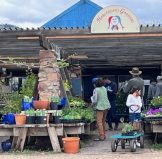 Dear Friends and Fellow Gardeners,
Dear Friends and Fellow Gardeners,

 It’s officially Summertime. We are struggling with an unprecedented June heat-wave and very low precipitation. But along with the heat, sun and lack of significant rainfall, there are some wonderful things happening that we can appreciate and be grateful for, like the bold, stand-out colors of summer blooms! Of the summer-blooming perennials we grow, both native and non-native, many are in bud or starting to bloom, are looking great and are ready now to bring out for sale. They ALL provide important sustenance for our pollinators, from tiny native bees, wasps and flies, to bumblebees, butterflies, and hummingbirds! And most are in 4” ‘deep pots’, easier to establish in the heat of the summer!
It’s officially Summertime. We are struggling with an unprecedented June heat-wave and very low precipitation. But along with the heat, sun and lack of significant rainfall, there are some wonderful things happening that we can appreciate and be grateful for, like the bold, stand-out colors of summer blooms! Of the summer-blooming perennials we grow, both native and non-native, many are in bud or starting to bloom, are looking great and are ready now to bring out for sale. They ALL provide important sustenance for our pollinators, from tiny native bees, wasps and flies, to bumblebees, butterflies, and hummingbirds! And most are in 4” ‘deep pots’, easier to establish in the heat of the summer! Welcome to Summer! Experientially, summer began last week with several days of intense heat that were challenging for people, pets, other critters, and plants. But in terms of hours of sunlight, the longest day of the year in the Northern Hemisphere will occur this Thursday, June 20 at 2:50 pm here in Colorado, officially beginning our summer season. Mikl has some thoughts on one of the interesting opportunities the Summer Solstice offers for gardeners with trees and shrubs.
Welcome to Summer! Experientially, summer began last week with several days of intense heat that were challenging for people, pets, other critters, and plants. But in terms of hours of sunlight, the longest day of the year in the Northern Hemisphere will occur this Thursday, June 20 at 2:50 pm here in Colorado, officially beginning our summer season. Mikl has some thoughts on one of the interesting opportunities the Summer Solstice offers for gardeners with trees and shrubs.  We’re celebrating all month, and we’d love to encourage you to support pollinators in your gardens.
We’re celebrating all month, and we’d love to encourage you to support pollinators in your gardens. 
 It’s not ideal, but sometimes you have to plant in the middle of a heatwave. Fortunately, it can be done successfully, even here in the high, windy and dry zone. High temperatures, wind and strong sunlight cause water to evaporate from plant leaves faster than the roots can take up water.
It’s not ideal, but sometimes you have to plant in the middle of a heatwave. Fortunately, it can be done successfully, even here in the high, windy and dry zone. High temperatures, wind and strong sunlight cause water to evaporate from plant leaves faster than the roots can take up water. Right now, we have our biggest selection of highly desirable plants for the season. Some of them are unusual and available in limited quantities. This includes a number of very choice native perennials that are very hard to find and will sell out fast, like:
Right now, we have our biggest selection of highly desirable plants for the season. Some of them are unusual and available in limited quantities. This includes a number of very choice native perennials that are very hard to find and will sell out fast, like: So many very special experiences!
So many very special experiences! 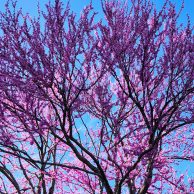 The fields and the foothills are turning green! So many trees are blooming or beginning to leaf out! There is so much energy bursting forth everywhere I look! After the lovely rain last weekend we emerged from our Sunday class to be greeted by the singing of frogs in a big puddle in the parking lot! How can they develop that fast???
The fields and the foothills are turning green! So many trees are blooming or beginning to leaf out! There is so much energy bursting forth everywhere I look! After the lovely rain last weekend we emerged from our Sunday class to be greeted by the singing of frogs in a big puddle in the parking lot! How can they develop that fast???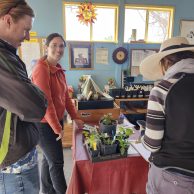
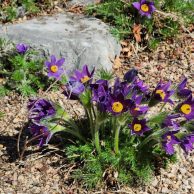
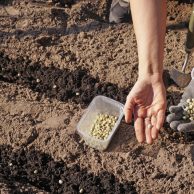 March is bringing us a characteristic tilt of the see-saw that this month always brings. Tank tops can go back in the drawer for a little while, as this week we will see night-time temperatures dipping into the mid-20s. We are expecting rain (~1.6 inches in Boulder, ~3 inches in Denver!), and heavy, wet snow, too. We’ve been here before; no need to panic. And we need the moisture!
March is bringing us a characteristic tilt of the see-saw that this month always brings. Tank tops can go back in the drawer for a little while, as this week we will see night-time temperatures dipping into the mid-20s. We are expecting rain (~1.6 inches in Boulder, ~3 inches in Denver!), and heavy, wet snow, too. We’ve been here before; no need to panic. And we need the moisture!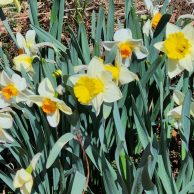 Dear Friends and Fellow Gardeners,
Dear Friends and Fellow Gardeners,
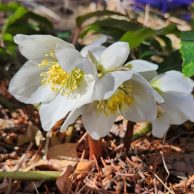
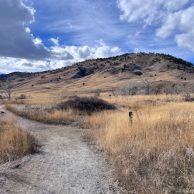
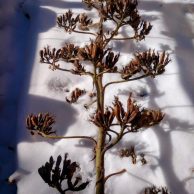


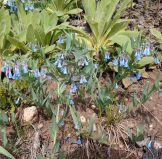
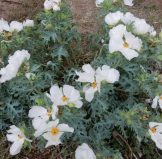
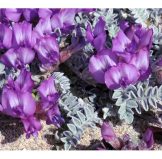
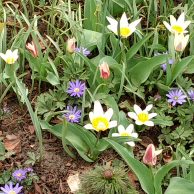
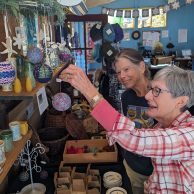 Well, that was a false alarm!
Well, that was a false alarm!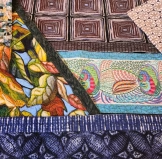
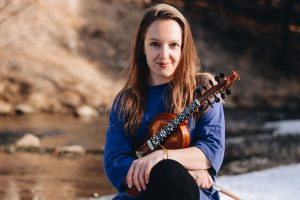


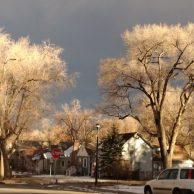
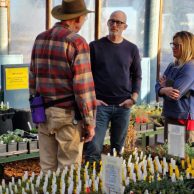

 The nursery industry is well aware that the majority of shoppers for plants are women. And it’s not just a cliché that women are the leaders in nurturing. Most of us are here because mothers took care of us when we were helpless. It is the spirit of motherhood, in people of all genders, that is turning lawns into gardens and gardens into habitat. When we take plants from pots and put them in to soil, they are helpless until they grow their roots into the earth. Our care and nurturing mothers them until they are more independent. Then our relationship becomes a partnership, and the plants give back to us, too.
The nursery industry is well aware that the majority of shoppers for plants are women. And it’s not just a cliché that women are the leaders in nurturing. Most of us are here because mothers took care of us when we were helpless. It is the spirit of motherhood, in people of all genders, that is turning lawns into gardens and gardens into habitat. When we take plants from pots and put them in to soil, they are helpless until they grow their roots into the earth. Our care and nurturing mothers them until they are more independent. Then our relationship becomes a partnership, and the plants give back to us, too.
 We’ve just endured one of the coldest and snowiest winters in the last 16 years.
We’ve just endured one of the coldest and snowiest winters in the last 16 years.
 Two quotations greet me every morning, posted on our bathroom mirror: “Tell me. What is it you plan to do with your one wild and precious life?” (poet Mary Oliver) and “I wake up each morning torn between a desire to save the world and a desire to savor the world. This makes it very hard to plan the day.” (author/editor E. B. White). The first inspires me to define my priorities, while the second, which perfectly describes my daily dilemma, allows me a little slack and sense of humor in the midst of my personal chaos and the chaos of life on Earth in this time. Perhaps you can take some inspiration and comfort from them, too.
Two quotations greet me every morning, posted on our bathroom mirror: “Tell me. What is it you plan to do with your one wild and precious life?” (poet Mary Oliver) and “I wake up each morning torn between a desire to save the world and a desire to savor the world. This makes it very hard to plan the day.” (author/editor E. B. White). The first inspires me to define my priorities, while the second, which perfectly describes my daily dilemma, allows me a little slack and sense of humor in the midst of my personal chaos and the chaos of life on Earth in this time. Perhaps you can take some inspiration and comfort from them, too.
 Spring is here and the time is right for dancing in the garden – to stay warm!
Spring is here and the time is right for dancing in the garden – to stay warm! We’re celebrating all month, and we’d love to encourage you to support pollinators in your gardens.
We’re celebrating all month, and we’d love to encourage you to support pollinators in your gardens. 




